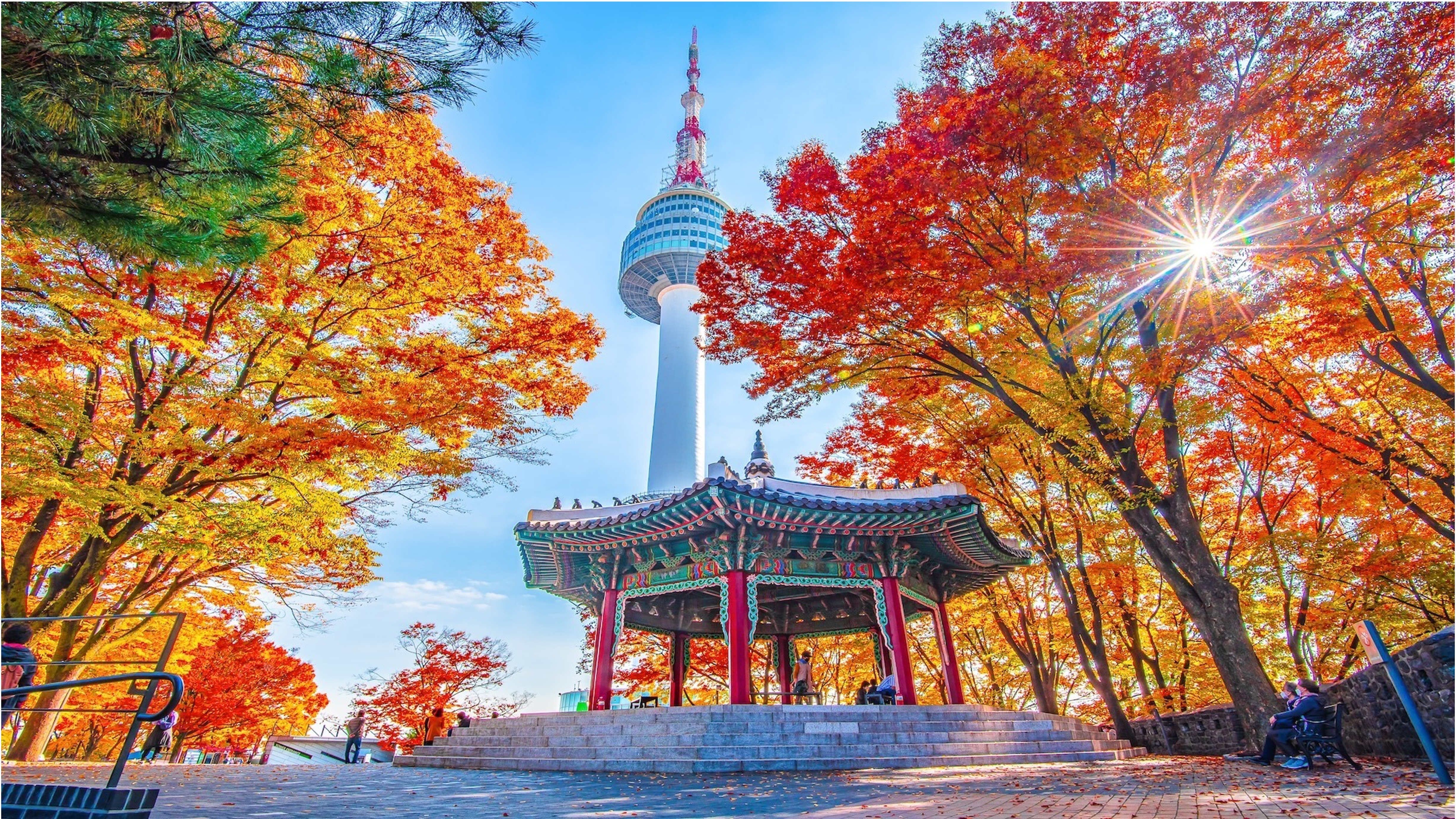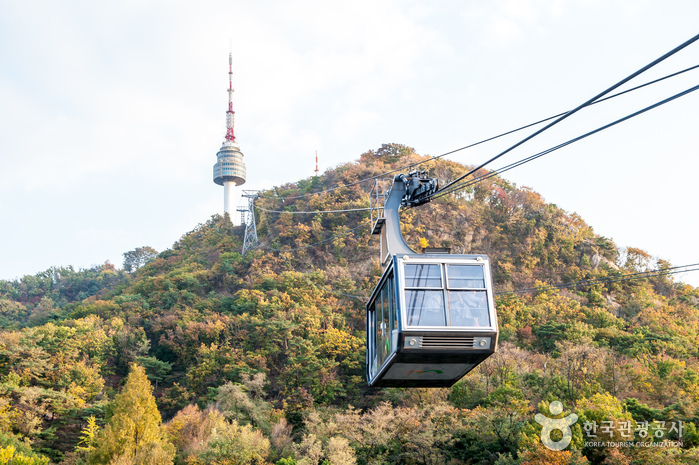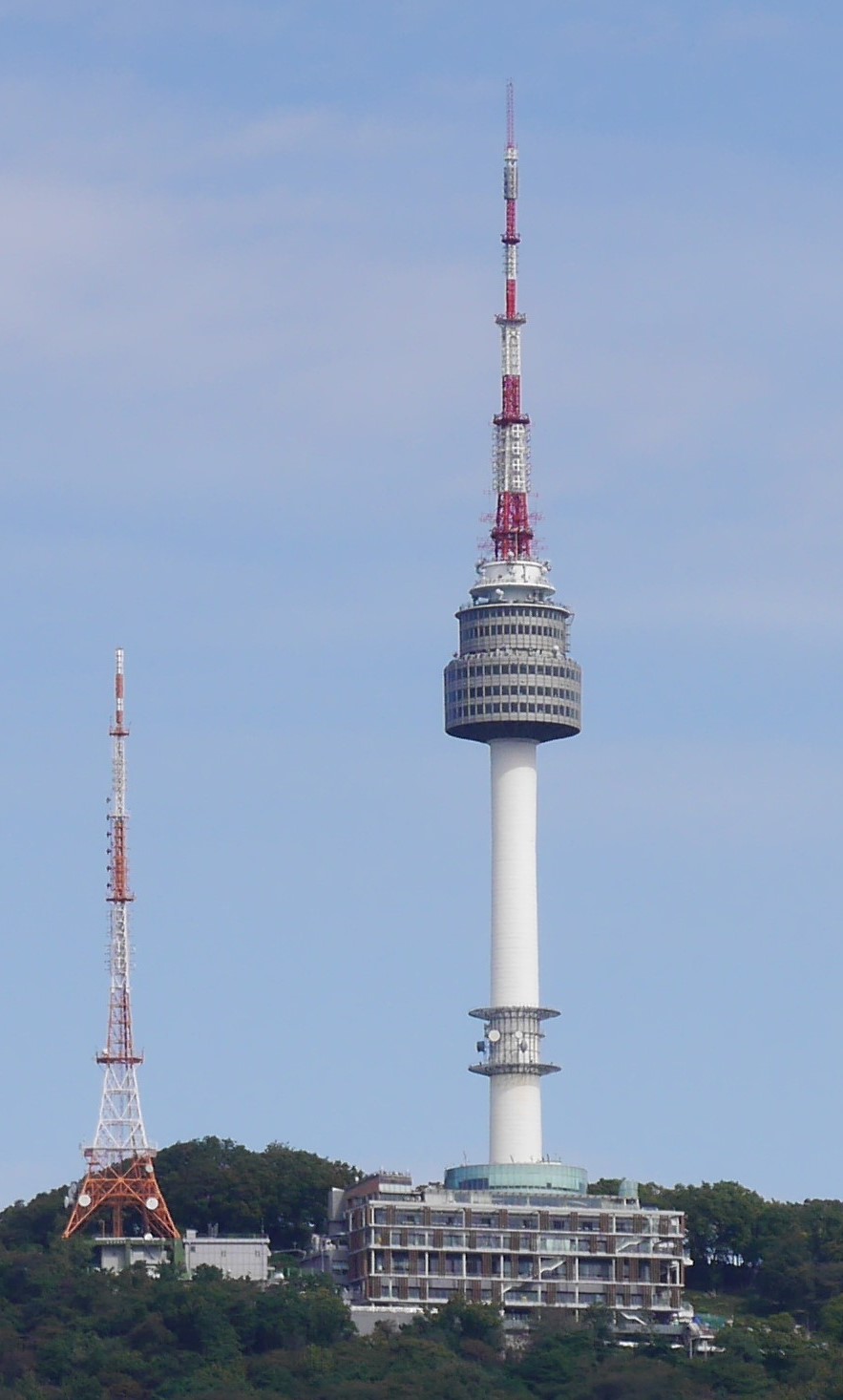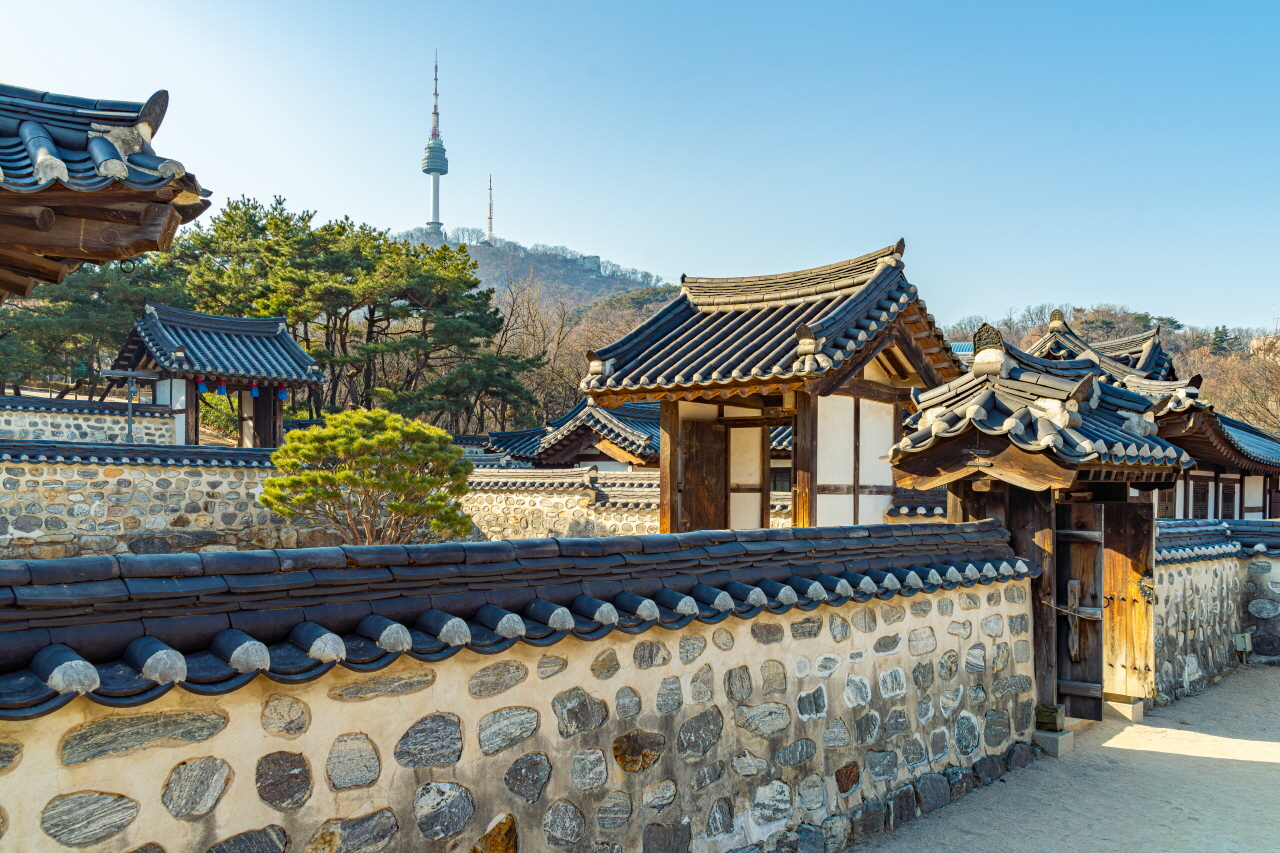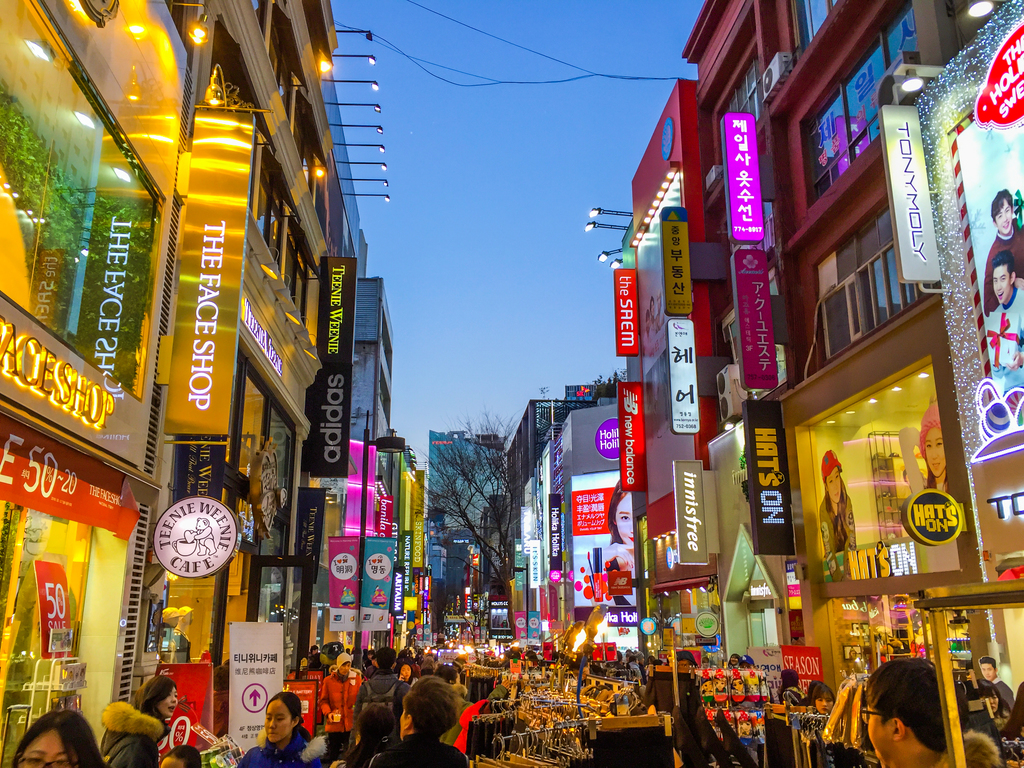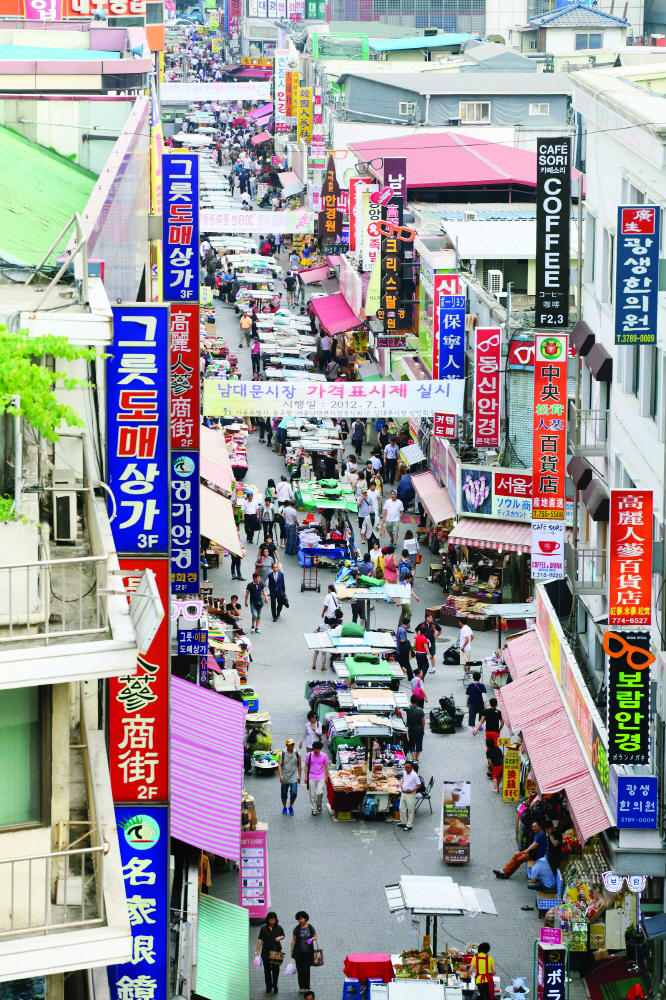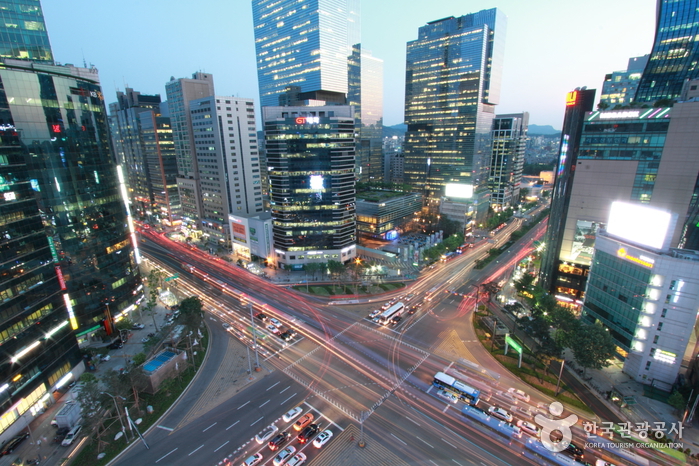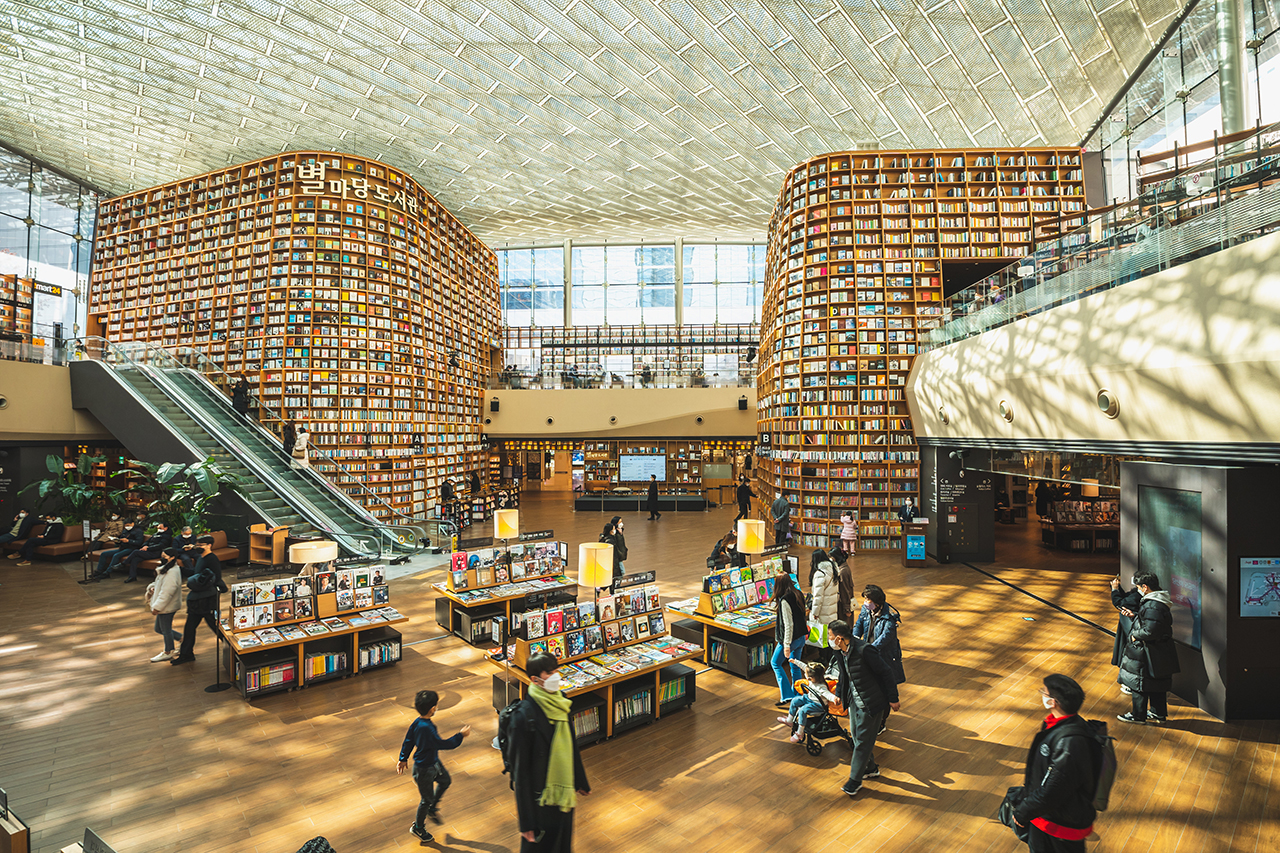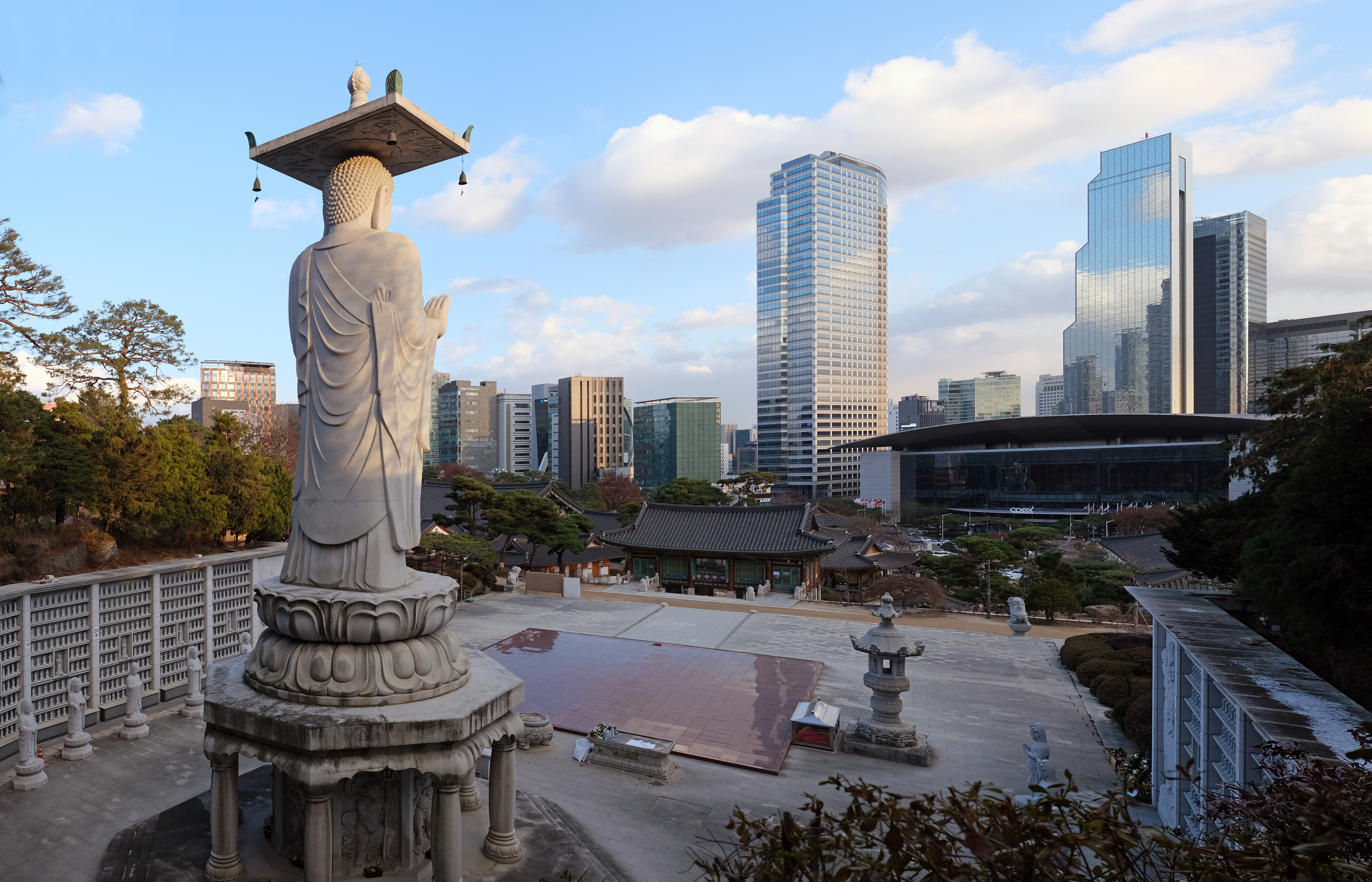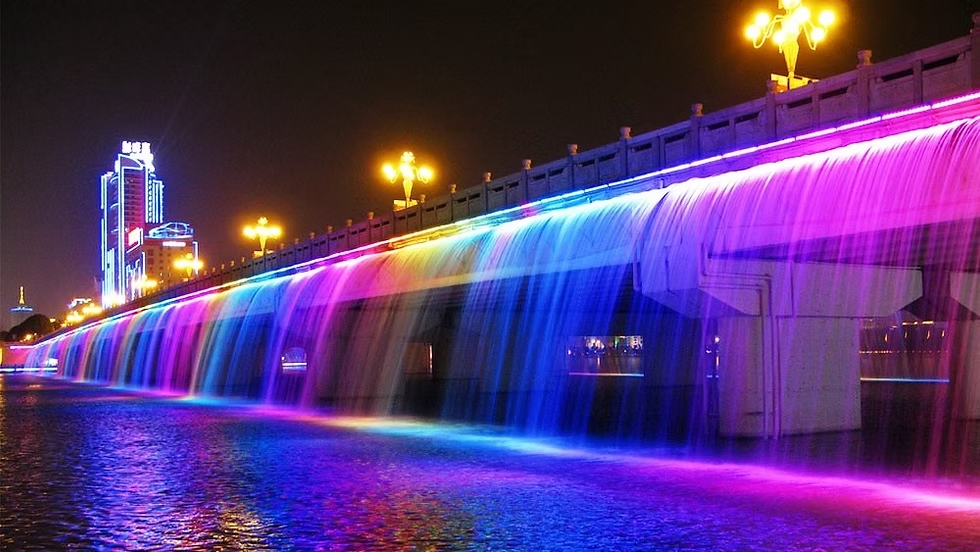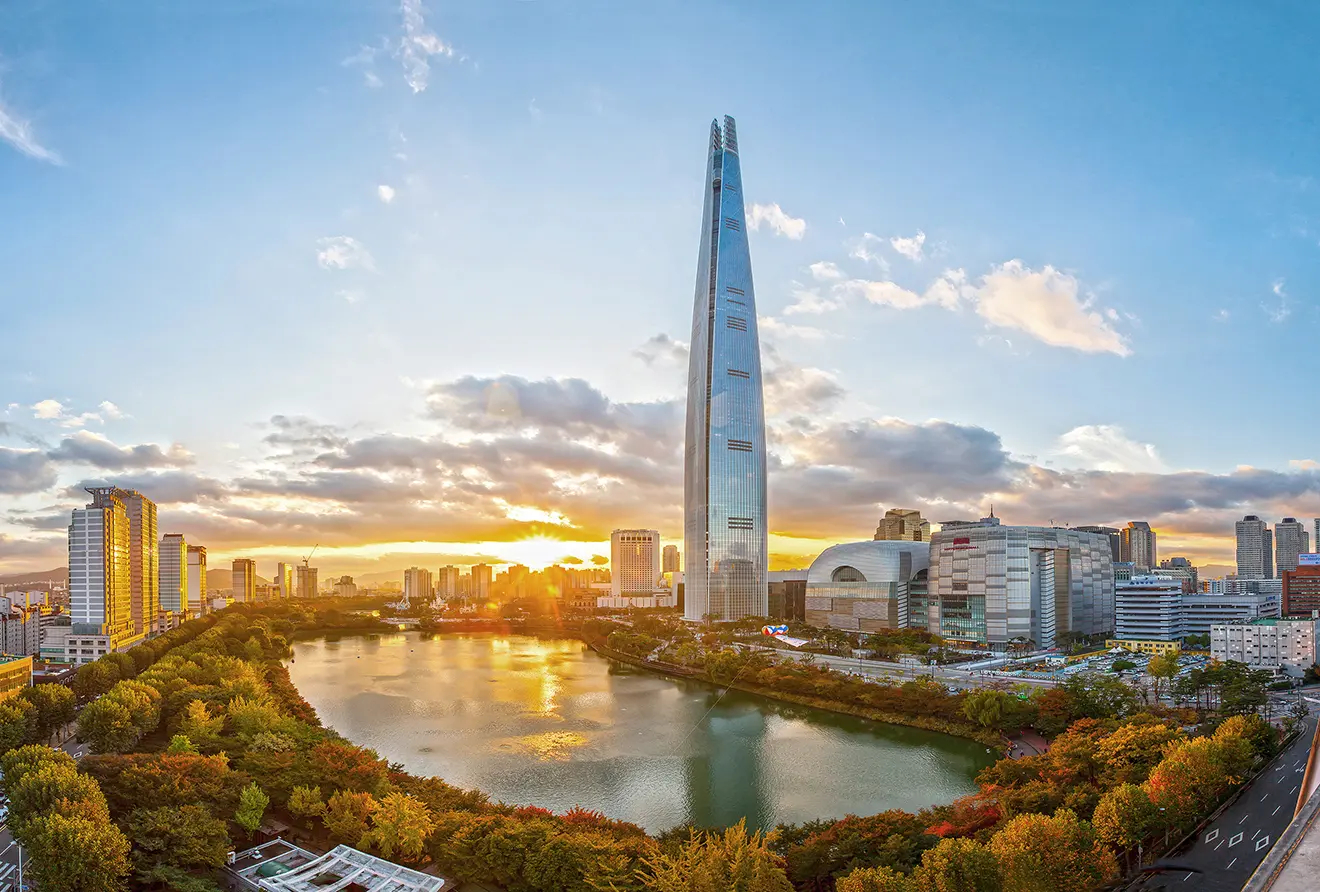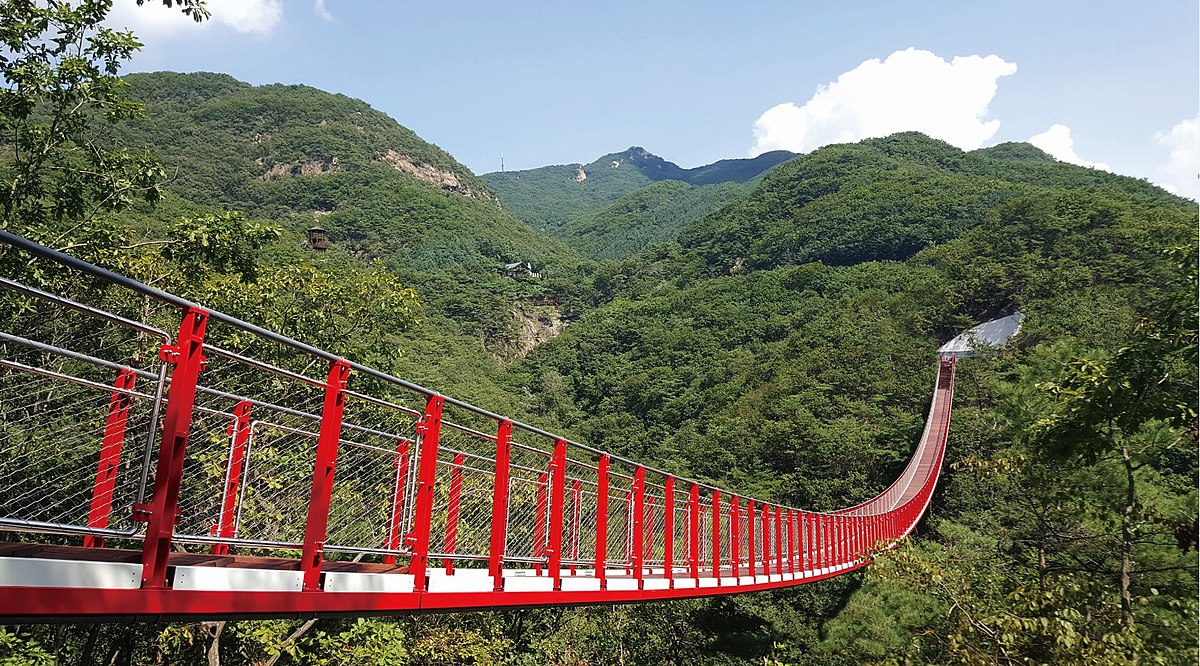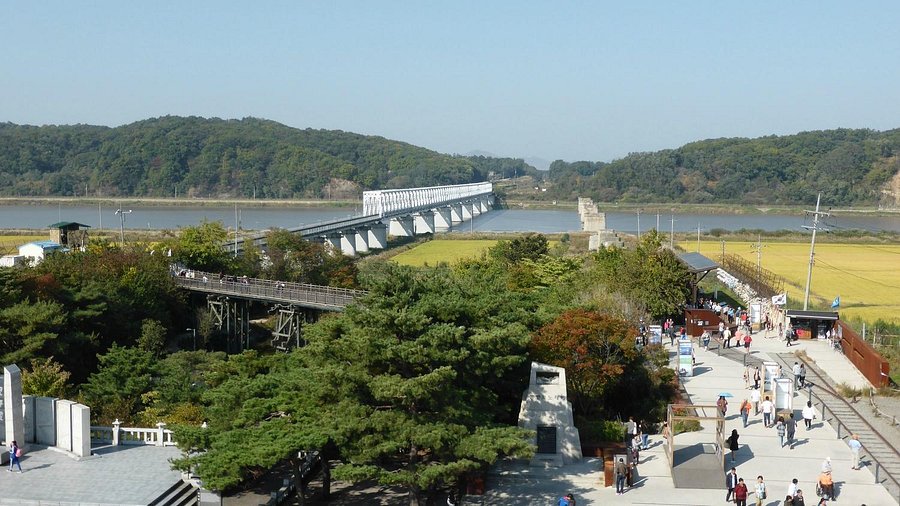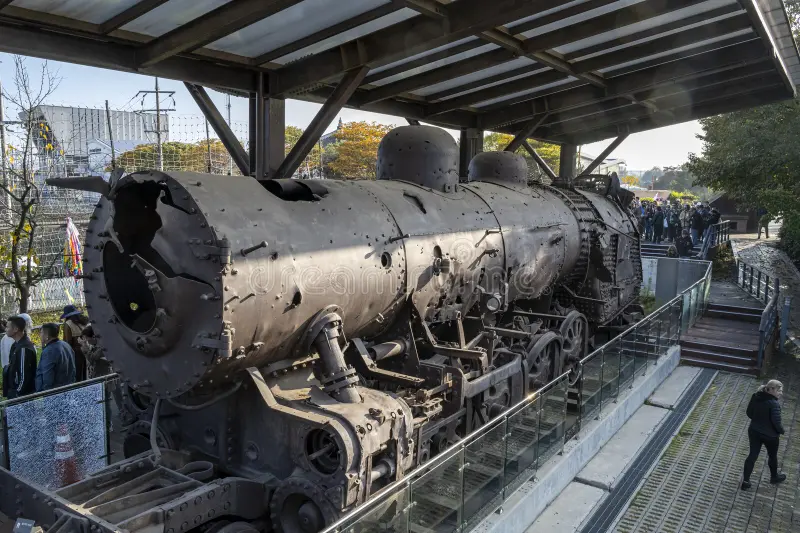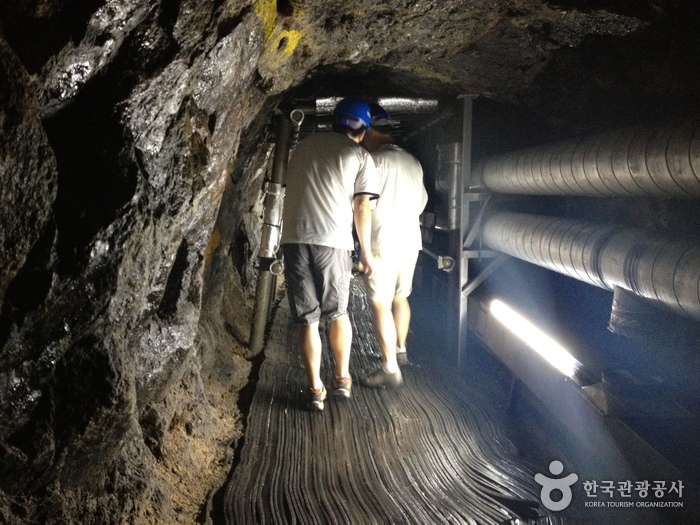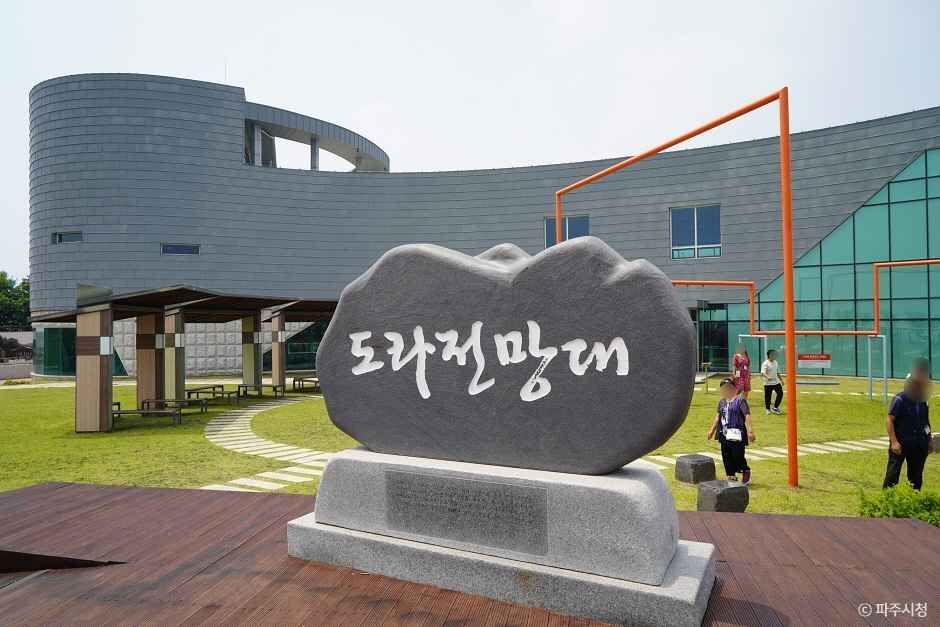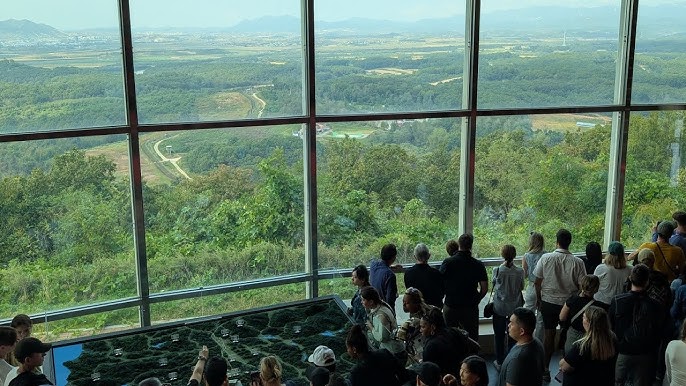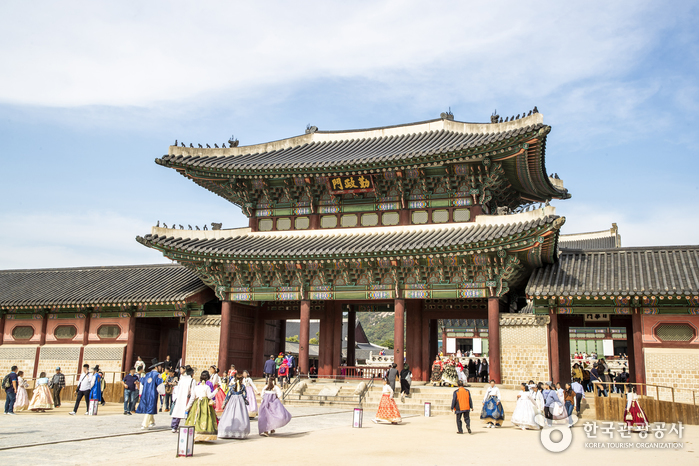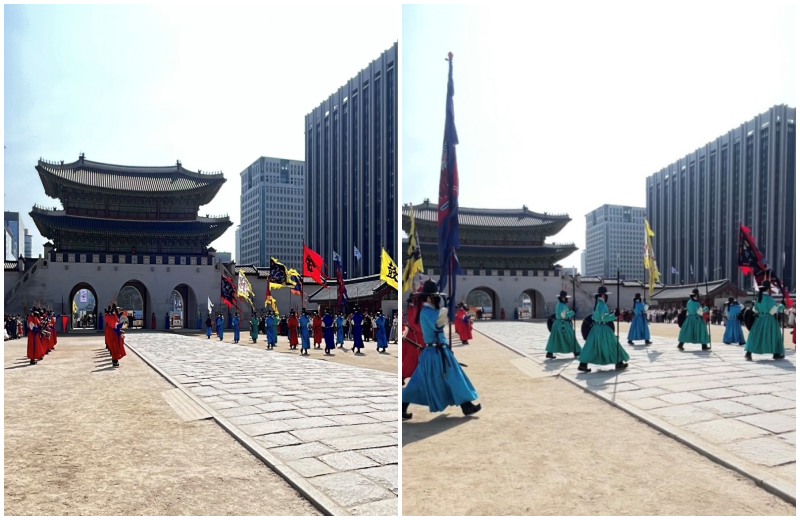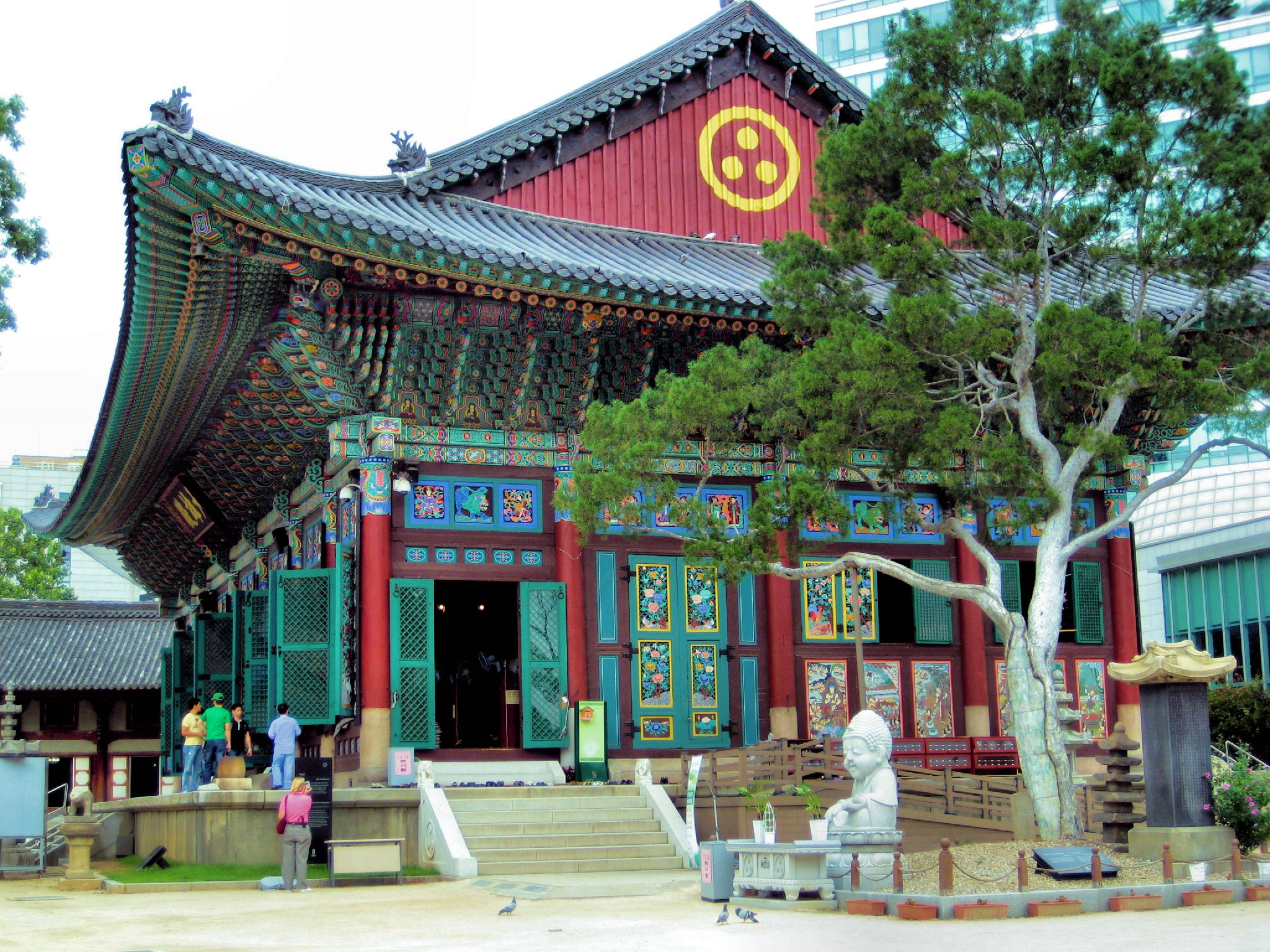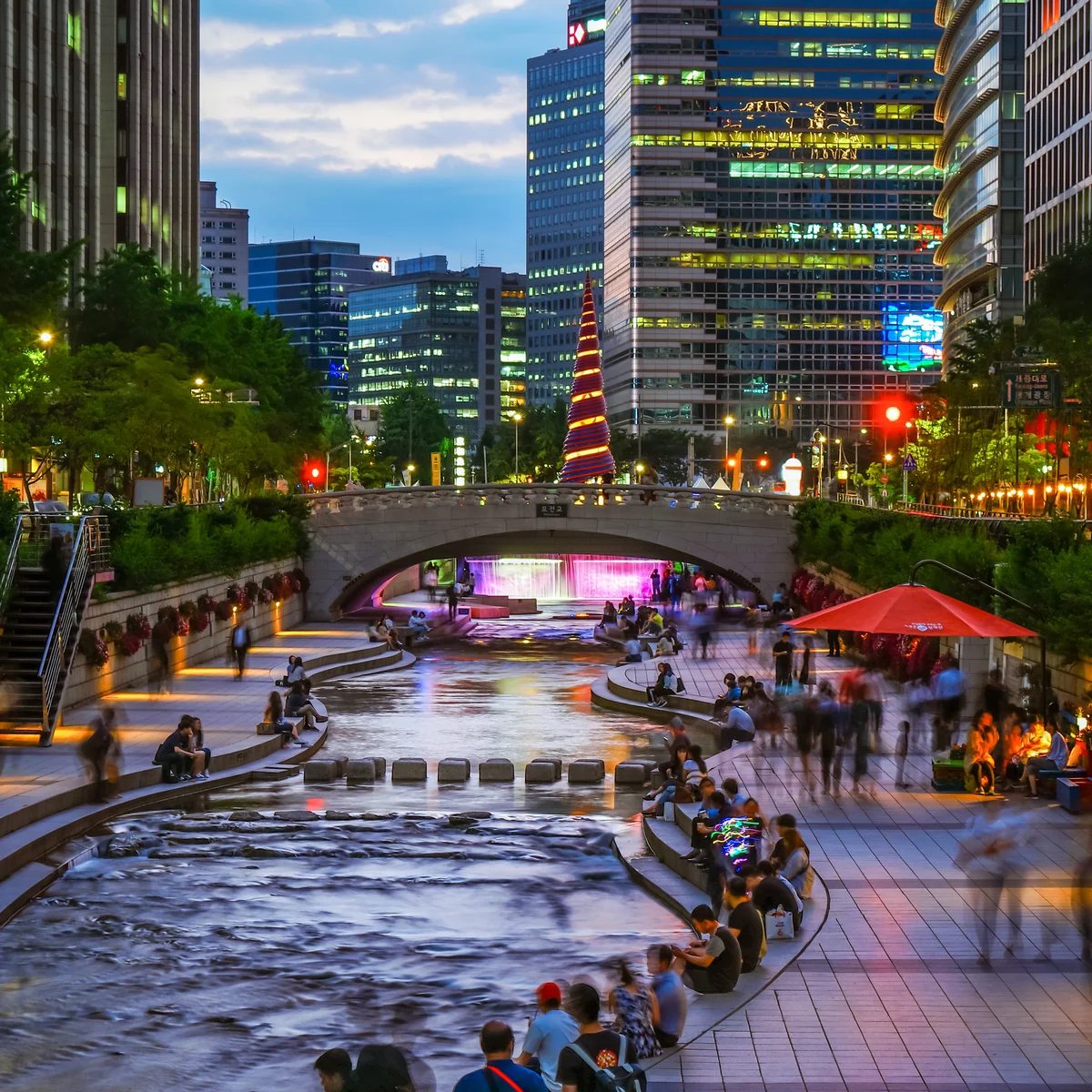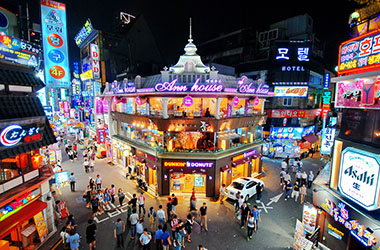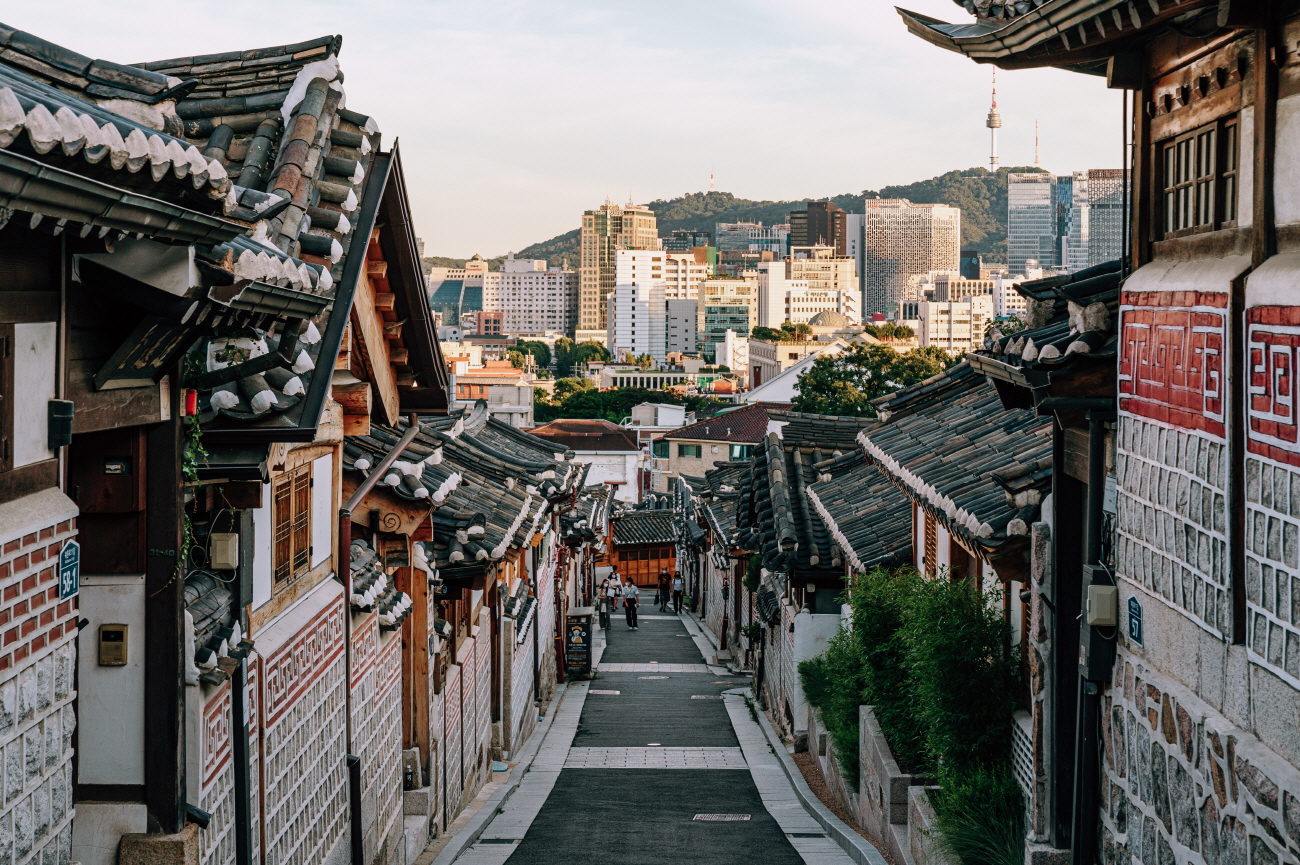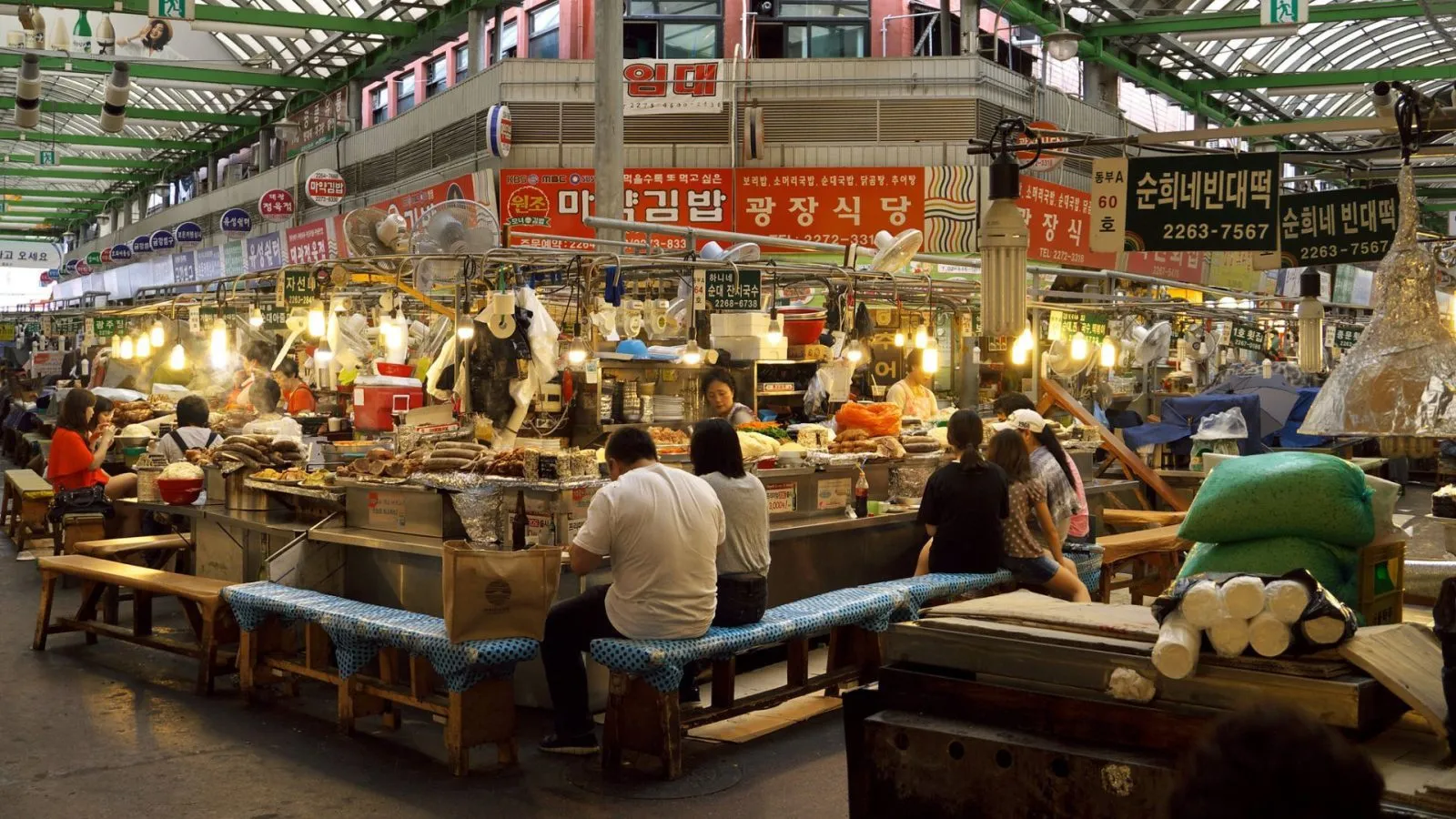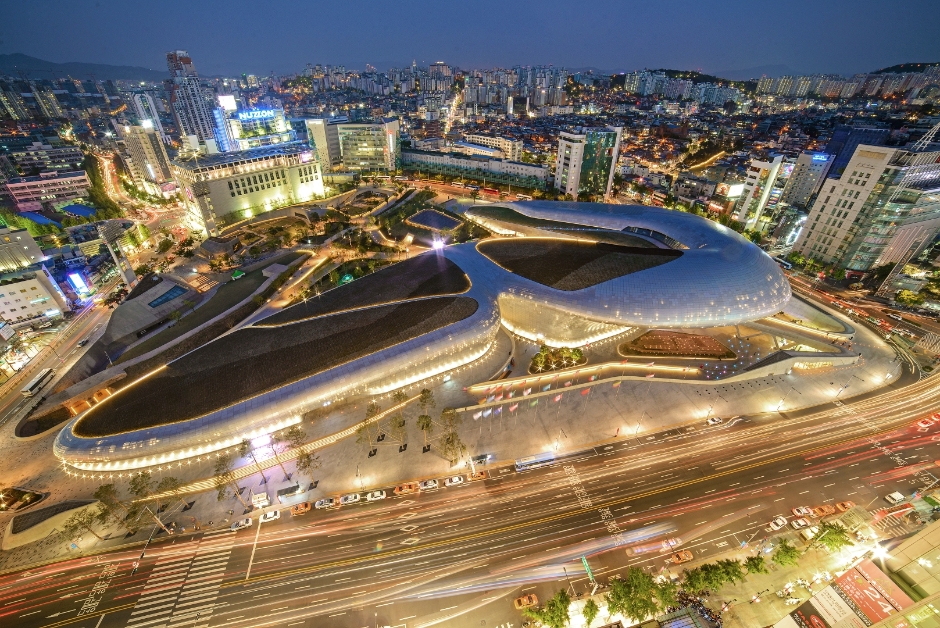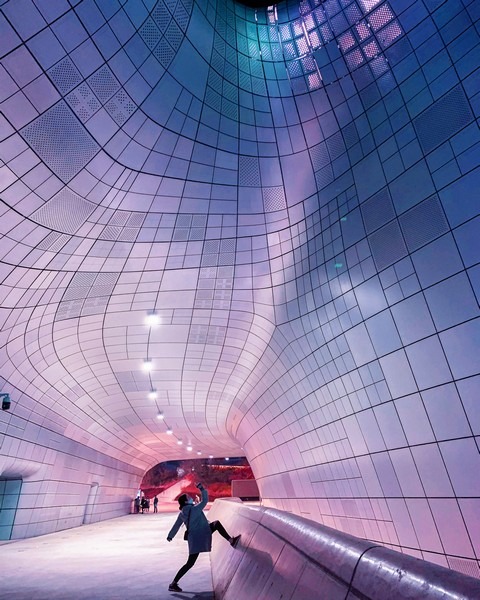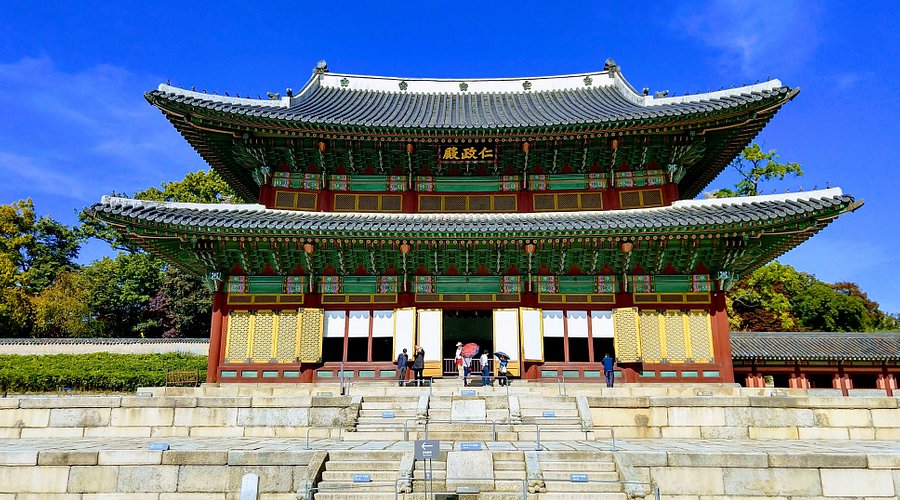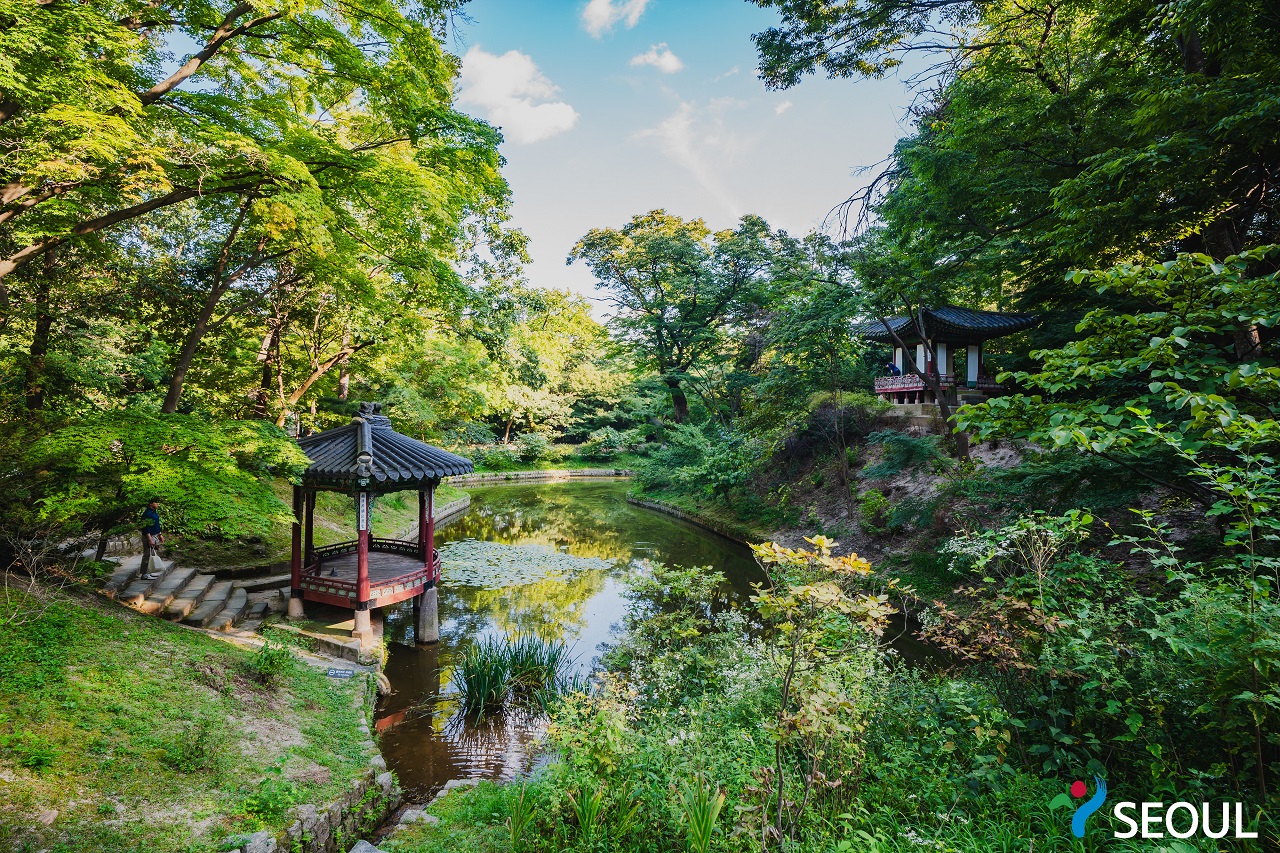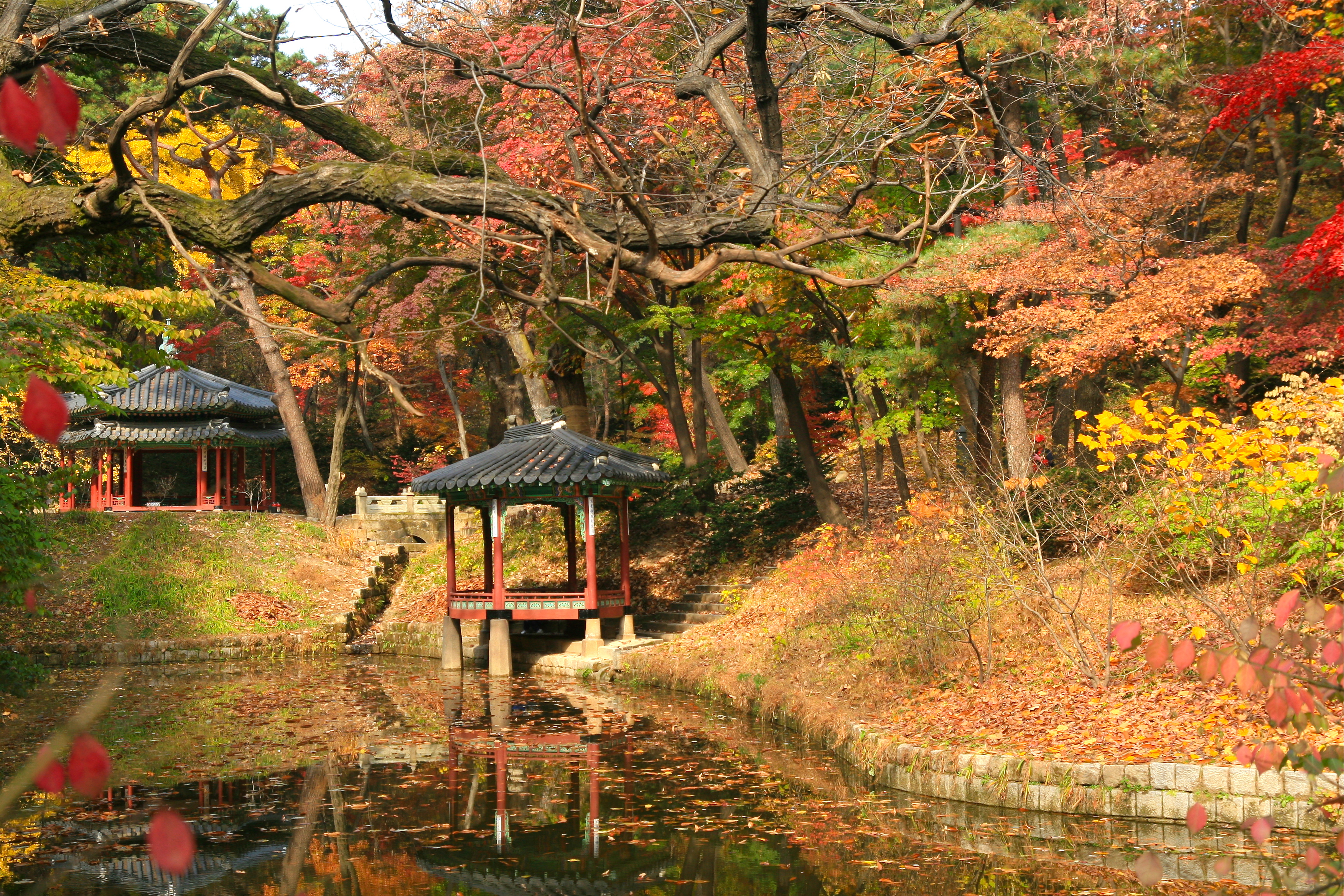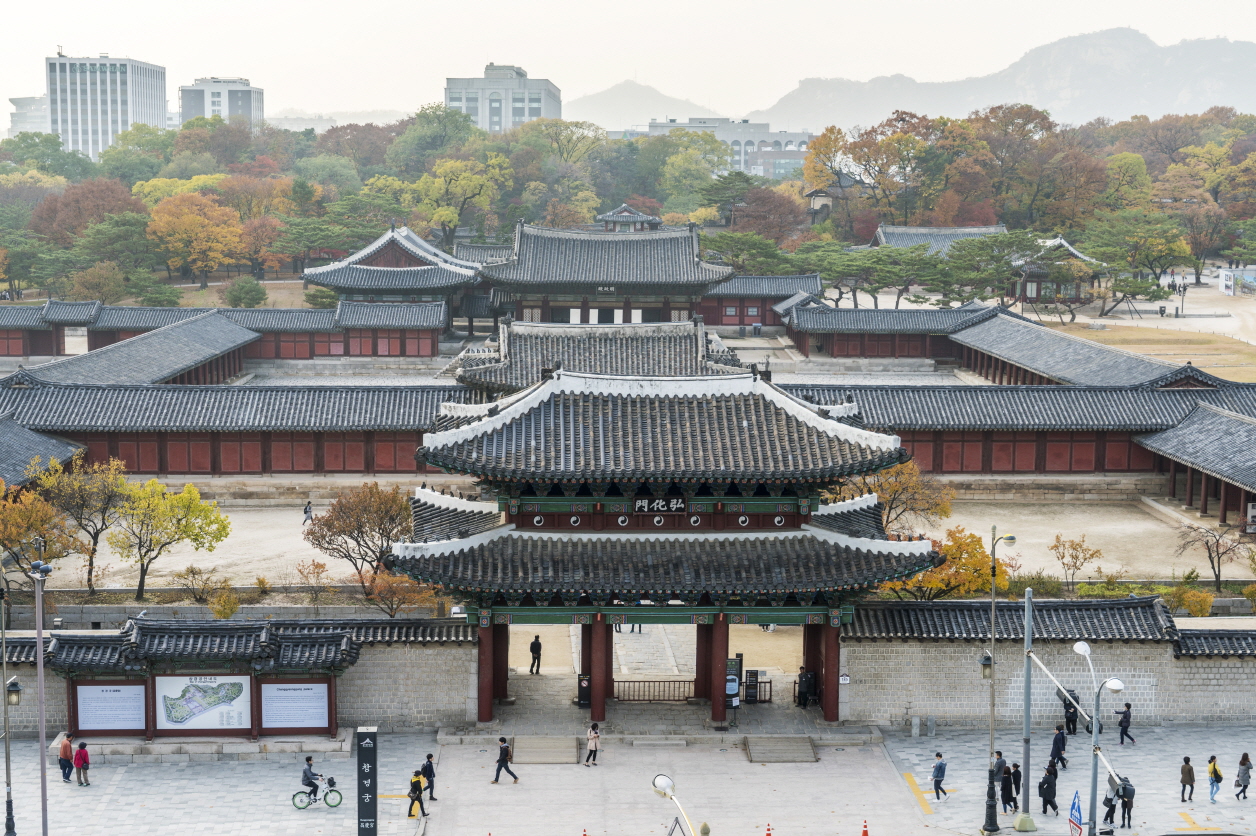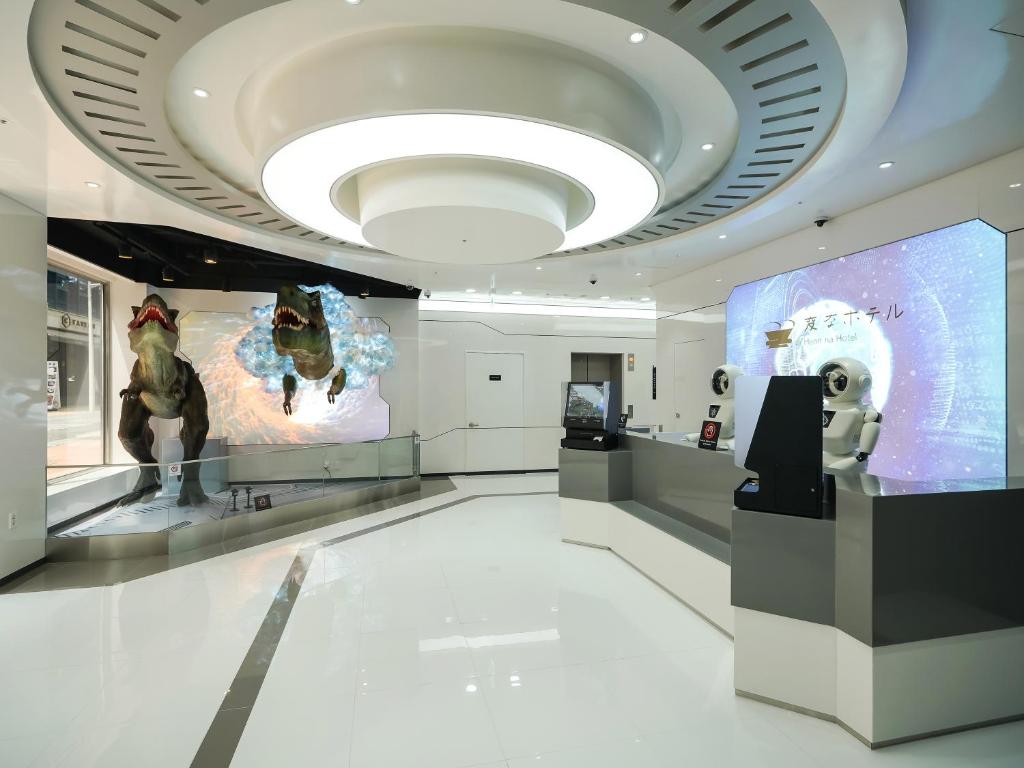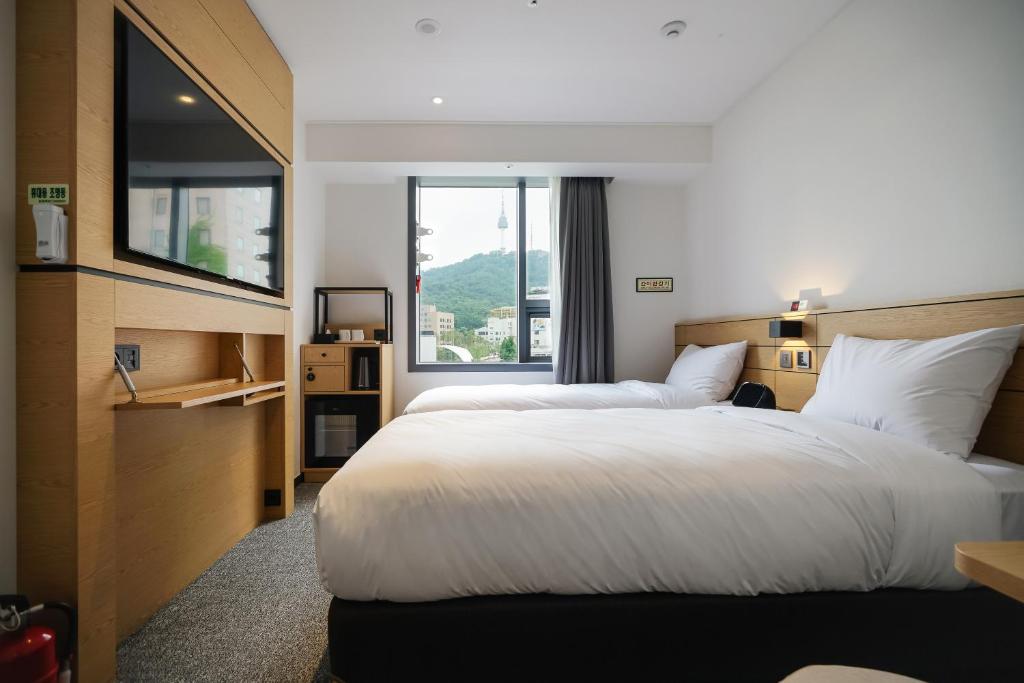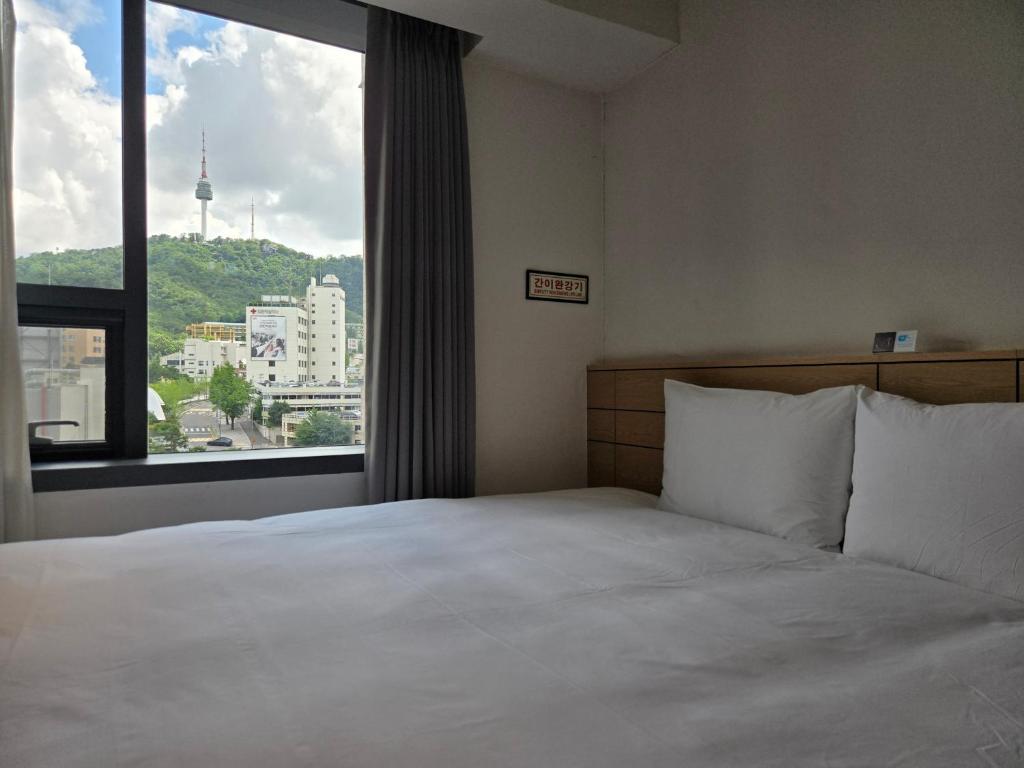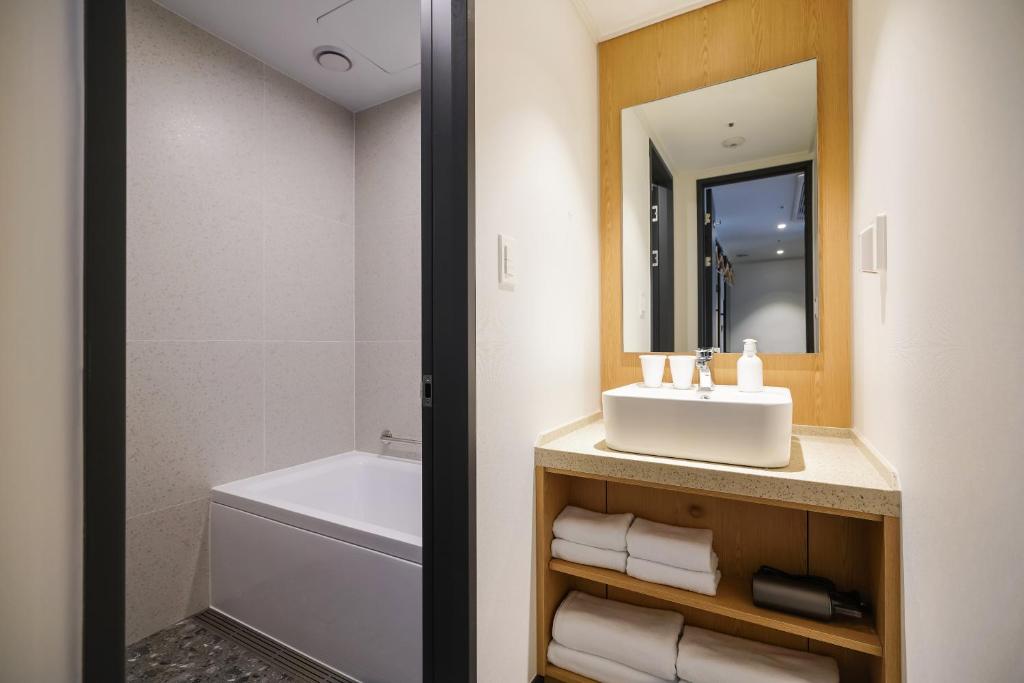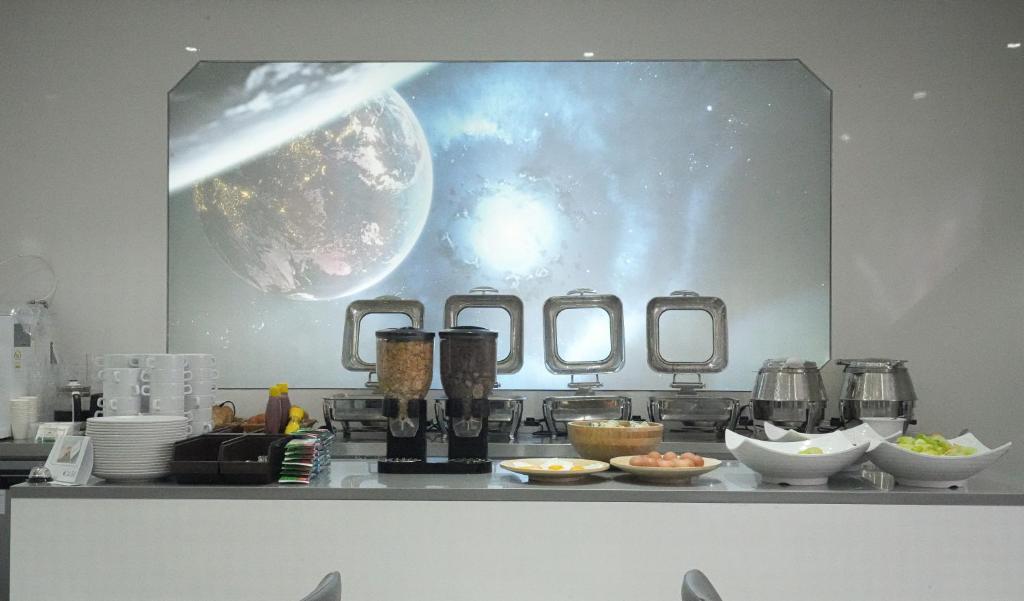Day 1
Transportation to Seoul
- Arrive at Incheon International Airport at 10.50
- Take the Airport Railroad Express (AREX) to Seoul Station
- Takes between 45 minutes - 1 hour
- Buy ticket online in advance
- From Seoul Station take the subway to Myeongdong Station
- Takes about 3 minutes
- Buy a T-money card at the station or airport for convenient travel on public transport
- Walk to Henn Na Hotel to drop off luggage
Note that talking in public transport is frowned upon in South Korea.
Namsam
Namsam is a mountain in the center of Seoul. The mountain is 262 meters high and close to Myeondong, next to our hotel. There are several hiking trails and picnic areas on the mountain, making it a popular spot.
Cable Care
This cable car is the first cable car in Korea, and it takes you from the base of Namsam to the top of the mountain. It was build in 1962 and is 605 meters long. The trail up the mountain is doable in about 30 minutes if you are fit, but since we will be jetlagged, we will take the cable car up.
Namsam Cable Car
N Seoul Tower
The main attraction on Namsam is the N Seoul Tower, also known as Namsan Tower or Seoul Tower. The tower is 236.7 meters high, and it was build in 1971 as a communication and observation tower. It is the second tallest structure in South Korea, after the Lotte World Tower. The tower has an observation deck, a revolving restaurant, and several cafes and shops. The observation deck offers panoramic views of Seoul, and it is a popular spot for tourists and locals alike.
N Seoul Tower
Namsangol Hanok Village
Namsangol Hanok Village is a traditional Korean village located at the base of Namsam. The village was established in 1976 to preserve and showcase traditional Korean culture and architecture. The village contains several traditional Korean houses (hanoks), a traditional garden, and a pond. If we have time and energy left, we can visit the village to experience traditional Korean architecture and traditions.
Namsangol Hanok Village
Myeondong Shopping Street
Myeondong is one of the main shopping districts in Seoul, and it is known for its fashion, beauty, and street food. The area is filled with shops, boutiques, and department stores, as well as street vendors selling a variety of snacks and treats. In the evening, the area comes alive with neon lights and bustling crowds. Our hotel is located in Myeondong, so we can easily explore the area and do some shopping and dining. I assume we will be here at least for a bit every evening during our stay in Seoul.
Myeondong Shopping Street
Namdaemun Market
Namdaemun Market is the largest traditional market in South Korea, and it is located near Myeondong. The market originates from the Joseon Dynasty, when it was established in 1414 as a small market. It has endured many hardships, including destruction during the Korean War, but has grown to become a bustling marketplace. In 2016, it counted 5200 stores and 9090 workers. Everything you can think of is sold here, from clothing and accessories to food and household items. Most goods are made directly from the vendors, so you can find unique and handmade items.
Namdaemun Market
Day 2
Gangnam
Gangnam, which stands for “South of the River”, is a district in Seoul that is known as the fancy part of the city. It is home to many high-end shops, restaurants, and entertainment venues. The song “Gangnam Style” by Psy, which became a global hit in 2012, is named after this district. The phrase “Gangnam Style” refers to the luxurious and trendy lifestyle associated with the area. A visit to Gangnam is a must when in Seoul.
Gangnam District
COEX Mall
The COEX Mall is the largest underground shopping mall in Asia, and it is located in the Gangnam district. The mall has over 300 stores, including fashion, beauty, and electronics shops, as well as a variety of restaurants and cafes. It also has a large aquarium, a movie theater, and a convention center. As a popular spot for both locals and tourists, a visit to the COEX Mall is a must when in Gangnam.
Starfield Library
One of the main attractions in the COEX Mall is the Starfield Library. The library is a large, open space with high ceilings and floor-to-ceiling bookshelves and has a collection of over 50,000 books.
Starfield Library
Bongeunsa Temple
Bongeunsa Temple is a Buddhist temple located in the Gangnam district, across the street from the COEX Mall. The temple was established in 794 during the Silla Dynasty, making it one of the oldest temples in Seoul. It is known for its beautiful architecture and serene atmosphere. The temple grounds include several buildings, including the main hall, a pagoda, and a bell tower. One of the main features is a large statue of the Buddha, which is one of the largest in South Korea.
Bongeunsa Temple
Banpo Bridge Moonlight Rainbow Fountain
- Sep-Oct 19:30, 20:00, 20:30, 21:00 (& 12:00 daytime show)
The Banpo Bridge Moonlight Rainbow Fountain is a popular attraction in Seoul, located on the Banpo Bridge over the Han River. The fountain is the world’s longest bridge fountain, with a length of 1,140 meters. The structure features over 10,000 LED nozzles that shoot water into the air, creating a colorful and dynamic display. The show is synchronized with music, and lasts for about 20 minutes. The fountain is a popular spot for both locals and tourists, and it is a great way to end the day in Seoul.
Banpo Bridge Moonlight Rainbow Fountain
Lotte World Tower & Mall
The Lotte World Tower is the tallest building in South Korea and the fifth tallest building in the world, standing at 555 meters tall. These 555 meters are divided over 123 floors, of which 6 are underground. The tower contains a variety of facilities, including offices, residences, a luxury hotel, an observation deck, and a shopping mall. The observation deck, called Seoul Sky, is located on the 117th to 123rd floors and offers panoramic views of Seoul. The shopping mall, called Lotte World Mall, is located at the base of the tower and contains a variety of shops, restaurants, and entertainment facilities.
Lotte World Tower
Day 3
DMZ Tour
- At 07.00 AM in the morning, meet the group at Myeongdong Station Exit 9 in front of the Sky Park Hotel III
- Arrival at 06.50 AM is recommended
- Bringing your passport is important
The demilitarized zone (DMZ) is a buffer zone between North and South Korea. It was established at the end of the Korean War in 1953 and is one of the most heavily fortified borders in the world. With a tour guide, you can actually visit this, if you are okay with waking up early.
Gamaksan Chulleong Bridge
The tour that we chose also includes the red suspension bridge. The red suspension bridge, actually called the Gamaksan Chulleong Bridge (also known as the Gloucester Heroes Bridge), is a prominent red suspension bridge in South Korea a short distance from the DMZ. This bridge, dedicated to British Korean War heroes, serves as a scenic crossing and viewpoint, offering panoramic views of the surrounding valley and mountains. The bridge is 150m long.
Gamaksan Chulleong Bridge
Then the tour continues on to all the important/touristy parts of the DMZ.
Imjingak Park
Imjingak Park is a park located near the DMZ and is a popular spot for tourists. The park was built in 1972 to console the families of those who were separated by the Korean War. The park contains many statues and monuments regarding the Korean War. It also contains the freedom bridge, which crosses the Imjin river, and it was used by South Korean soldiers during the war. Until 1998 it was also the only point of egress from South Korea to the DMZ.
The monuments include:
- Second Infantry Division Memorial, which is the first major US unit to reach Korea. It is said that the division’s clerks, bandsmen, technical and supply personnel all helped to fight off the KPA (Korean People’s Army from North Korea).
- 187th Airborne “Rakkasans” Memorial, which led the second and last parachute asssault in Korea in 1951.
- Chamorros of Guam Memorial, since 1000 Guamanians served in the US military during the Korean war. 20 people died.
- Japanese American Korean War Veteran Memorial, since a lot of Japanese Americans served in the US military during the Korean war. 255 people died.
- Mangbaeddan, which enables displaced people whose hometowns are located within North Korea to bow down to their parents or family in North Korea as a sign of respect during cultural events such as New Years and Chuseok (the Korean Mid Autumn Festival, which usually entails paying respect to your elders and ancestors). This memorial holds many sorrowful memories of separated families during the Korean War.
- Monuments to US Forces in the Korean War, built by the South Korean Ministry of Defense, to commemerate the sacrifice and achievements of US troops. 37000 Americans died.
- Peace train, the last train to cross the border between North and South Korea, a military transport delivering supplies to UN forces following MacArthur’s inland push in 1950, became stuck at Hanpo Station in Hwanghe-do in what is now North Korea on December 31, 1950 due to Chinese troops ahead. Unable to turn around, the conductor attempted to back the train back down to Munsan but was stopped by US troops who decided that rather than risk the train falling into North Korean hands, were ordered to destroy the train. The locomotive was a KNR Mateo1 Class.
Imjingak Park
The Third Tunnel
The Third Tunnel of Aggression is one of the four known tunnels dug by North Korea under the border into South Korea. The tunnel was discovered in 1978 because of an underground explosion. The tunnel is 1635 meters long, 1.95 meters high, and 2.1 meters wide. It runds 73 meters underground. It was allegedly designed for a surprise invasion of South Korea and could accomodate 30.000 men per hour with light weaponry. There are assumed to be 20 more tunnels besides the four that are known. Tourist can now visit the tunnel, but keep in mind that it is a steep walk down and up again, and it can be quite claustrophobic.
Third Tunnel
The Dora Observatory
Dora Observatory is the closest DMZ observatory to Panmunjeom. From Dora Observatory, one can see not only the Panmunjeom but also the village of Daeseong-dong within the DMZ, mountains and farmlands on the North Korean side, and the city of Gaeseong, a North Korean city and the historic capital of Goryeo (918-1392). This can be seen through binoculars that are available for visitors. The village is said to be a propaganda village. According to North Korea, the village contains 200 families while the South Korean government claims it is uninhabited. It also displays the currently seventh tallest flagpole in the world, standing at 160 meters. Additionally, there are loud speakers in the village that used to deliver DPRK propaganda to South Korea.
Dora Observatory
After the tour, the bus will bring us back to Myeongdong Station, where we can enjoy some shopping and dining in the Myeondong Area.
Day 4
Vibing in Insa-dong
Insa-dong is a neighborhood in Seoul that is known for its traditional Korean culture and arts. The area is filled with traditional Korean houses (hanoks), art galleries, antique shops, and tea houses. It is a popular spot for both locals and tourists who want to experience traditional Korean culture. Insa-dong is also known for its street food, with many vendors selling traditional Korean snacks and treats. A visit to Insa-dong is a must when in Seoul.
Gyeongbokgung Palace
- 13.00 ceremony of guarding Gwanghwamun Gate
- 14.00 Royal Guard Changing Ceremony
- Tours are at 11:00, 13:30, 15:30
Gyeongbokgung Palace, also known as Gyeongbok Palace, is a royal palace located in the heart of Seoul. The palace was built in 1395 during the Joseon Dynasty and served as the main royal palace and its many kings for over 500 years. The complex includes several buildings, including the main hall, throne hall, and royal residences. It is regarded as the biggest and most beautiful of the Five Grand Palaces built during the Joseon Dynasty. The sculptures in the Geunjeongjeon Hall exemplify Joseon-era sculptures. There are also two museums, the National Palace Museum of Korea and the National Folk Museum of Korea, located on the palace grounds.
The Royal Guard Changing Ceremony at Gyeongbokgung Palace is a daily reenactment of the Joseon Dynasty guard-changing procedure at the main Gwanghwamun Gate. The free ceremony occurs at 10:00 AM and 2:00 PM. At 1:00 PM, there is also a special dispatch ceremony of the royal guards at the Gwanghwamun Gate. It should be fun to watch.
Gyeongbokgung Palace
Gwanghwamun Gate
Gwanghwamun Gate is the main and largest gate of Gyeongbokgung Palace. It is a symbol of Seoul’s history as the capital of Joseon and Korea. It was first completed at 1395, so definitely and old gate. The name was given by Sejong the great in 1426, and has many theorized meanings, including “era of peace”, or “spreading the dignity and virtue of the country far and wide.” During the Korean war all the wood burnt away, but it was reconstructed in 1968. Watching the guards changing ceremony here is a very popular activity.
Jogseya Temple
Jogseya temple is a Buddhist temple, and also the district head temple of the Jogye order in Seoul. The temple was built in the late 14th century, but burnt away at some point. Later it was rebuilt again and has undergone many name changes. The present day name comes from a purification drive to eliminate Japanse influence.
Jogseya Temple
Cheonggyecheon Stream
This stream is 10.9 km long and runs through downtown Seoul. It is a natural stream that previously functioned as a sewage system. But after 281 million dollars, it was restored between 2003 and 2005 to its current state. This resurrection was seen as a great success, since it has improved the quality of life in the surrounding. It also serves as a peaceful place to relax and escape the busy city life.
Cheonggyecheon Stream
Hongdae
- In the evening
Hongdae is a very notorious neighborhood in Seoul. It is the place where all the young people hang out. There are many clubs, bars, and restaurants in the area, as well as street performers and artists. Karaoke is also very popular in this area. A visit to Hongdae in the evening is a must when in Seoul to experience the craziness of this neighbourhood.
Hongdae District
Day 5
- Depart the hotel on time to go to Myeondong Station
- From Myeondong Station take the subway to Seoul Station (3 minutes)
- From Seoul station take the Airport Railroad Express (AREX) to Gimpo Airport (22 minutes)
- Flight to Jeju Island at 12.45 from Gimpo Airport
Day 20
- Arrive by car from Sokcho.
- Hand in the car at LOTTE rent-a-car before 20.00
- Address: 151-21, Samseong-dong, Gangnam-gu, Seoul, Republic of Korea
Bukchon Village
Bukchon village is a tradional Korean village located in the old part of Seoul surrounded by the palaces. It is known for its well-preserved traditional Korean houses (hanoks) and its picturesque streets. The name Bukchon stands for “northern village”, as it is located north of the Cheonggyecheon Stream and Jongno area. This village is one of the most popular tourists spot in Seoul, and that is very noticeable, so it might be very busy. Note that the village is still a residential area, so be respectful when visiting.
Bukchon Village
Hanok Stay
To experience Bukchon village in a more peaceful way, we decided to stay in a traditional Korean hanok stay for two nights. We will stay at Rakkojae, which is located in the heart of Bukchon village. More information about the stay can be found in the accommodations section below.
Gwangjang Market
Gwangjang stands for “to gather from afar and keep altogether”. It was the first permanent market in Korea and it is a very popular tourist spot. There are many things you can buy here, but it is most famous for its food.
Gwangjang Market
Optional: Dongdaemun Design Plaza (DDP)
Dongdaemun Design Plaza (DDP) has a meaning of Dream, Design, and Play. It holds various exhibitions, fashion shows, forums, conferences, and other domestic and international events. The architecture is very unique and interesting, so that makes it a popular spot to visit.
Dongdaemun Design Plaza
Day 21
Palaces
In total there are 5 palaces in Seoul. We will not visit all of them, but some of them are definitely worth a visit. We have already been to Gyeongbokgung Palace on day 4, but Changdeokgung Palace, and Changgyeonggung are also worth a visit. They are both close to our hanok stay in Bukchon village, so we can easily walk there.
Changdeokgung Palace
Changdeokgung Palace was the second royal villa built following the construction of Gyeongbokgung Palace in 1405. It was the principal palace for many kings of the Joseon dynasty. The palace grounds are comprised of a public palace area, a royal family residence building, and the rear garden. Known as a place of rest for the kings, the rear garden boasts a gigantic tree that is over 300 years old, a small pond and a pavilion.
The palace gained importance starting from the time of Seongjong, the 9th king of Joseon, when a number of kings began using it as a place of residence. Unfortunately, the palace was burned down by angry citizens in 1592 when the royal family fled their abode during the Imjin War. Thanks to Gwanghaegun, the palace was restored in 1611.
Changdeokgung Palace
Secret Garden
The Secret Garden, also known as Huwon or Biwon, is a large garden located within the grounds of Changdeokgung Palace. The garden now showcases traditional Korean landscaping and architecture, including pavilions, ponds, and bridges. It is almost 450000 square meters large, and it was originally built as a private garden for the royal family. There are only 100 visitors allowed in the garden at a time, and you can only enter with a guided tour. You thus need to book in advance!
Secret Garden
Changgyeonggung
This palace was built around the 15th century by King Sejong for his father Taejong. During japanse occupation, it was used as a zoo and botanical garden. But the palace was restored to its original state in 1983. There are some interesting things to see, like the Honghwamun, the main gate, Okcheongyo, a pretty stone bridge, Myeongjeongjeon, the main hall, and munjeongjeon, the king’s private residence.
Changgyeonggung Palace
Rest of the day can be dedicated to exploring all the things in Seoul we still want to see.
Day 22
- Go to Seoul Station by subway from Bukchon village (~40 minutes).
- From Seoul Station take the Airport Railroad Express (AREX) to Incheon International Airport (about 1 hour).
- Take our flight back home at 13.05.
Accommodations
Henn Na Hotel Myeongdong
- Day 1-5
- Check-in from 15.00, check-out before 12.00
- Address: 59, Myeongdong 8ga-gil, Jung-gu, Jung-Gu, 04537 Seoul, South Korea
The Henn Na Hotel is a hotel branch from Japan that is known for its unique concept of incorporating robots into its services. The location of this hotel is in the heart of Myeondong, a famous shopping district. This location is not only central, but also extremely close to the meet up point for the DMZ tour. And since you have to meet up early in the morning, I would say that is certainly a big plus. There is an option to bring your luggage before check-in, which is also an absolute must. An American breakfast is served. I would prefer traditional Korean breakfast, but since this is our first stop, a breakfast that is more familiar might be a good idea. I think there are only two main downsides, the rooms are quite small according to reviews, and it is quite expensive. However, with this location in Seoul, it is impossible to find something cheap.
We booked two rooms, a twin room with two single beds and the Hollywood room with one extra large double bed. The twin room should be quite basic, but the Hollywood room also promises a great view, so we will see about that.
Henn Na Hotel
Rakkojae
- Day 20-22
- Check-in from 15.00, but need to notify in advance, check-out before 11.00
- Address: 218 Gahoe-dong, Jongno-gu, Seoul
For our last two nights, we decided to stay at Rakkojae, a traditional Korean hanok stay, which is located in Bukchon Hanok Village. Bukchon Hanok Village is a prime tourist spot in Seoul, known for its well-preserved traditional Korean houses (hanoks) and its picturesque streets. To be able to fully experience the charm of this area, and to immerse ourselves in the traditional Korean culture, we have decided to stay at one of the Hanoks.
So why is it special to stay in a traditional Hanok? Well, the houses are more than 100 year olds and preserve the architectural style and cultural heritage of Korea. Staying in a traditional Hanok not only comes with the accomadation, but also with the experience. When arriving in the village, you are welcomed with a traditional tea service. Furthermore, a traditional Korean or American breakfast is served in the morning. Additionally, for free you can use their Natural Mud Sauna to relax, or try on a traditional Hanbok (Korean dress) and take pictures with it on their beautiful premise. For an additional fee, you can also experience their Boksoondoga Makgeolli Skincare Bath, which is a bath with rice wine, known for its skin benefits, or you can listen to the sounds of a Gayageum performance. You do have to keep in mind that all of these experiences are really traditional, so be prepared to sleep and sit on the ground, but that is of course also the charm.
We have booked the family suite called Sarangbang, which can accomadate up to four guests.
Rakkojae Hanok Sarangbang in Bukchon Village
Food
- Korean BBQ is a must-try when in Seoul.
